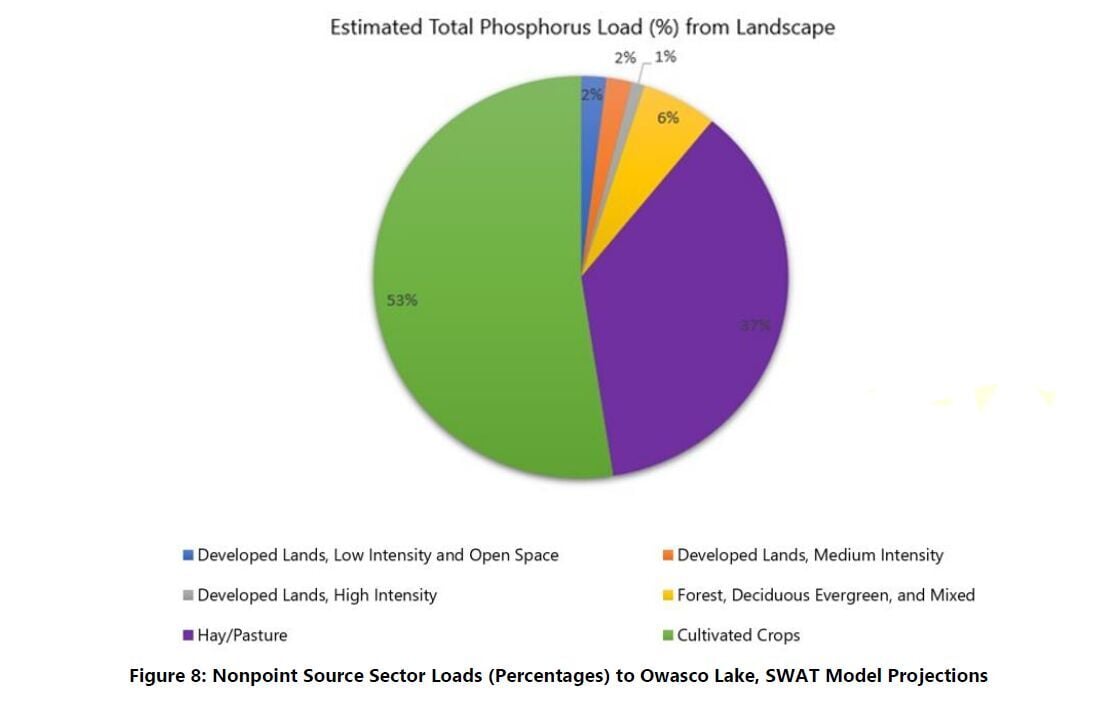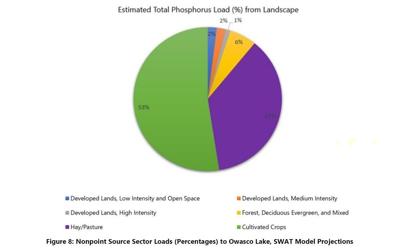A state-funded, science-driven plan to reduce the amount of phosphorous that runs into Owasco Lake is nearing completion, and a newly released draft concludes that farm land is by far the biggest source of this problematic nutrient.
The draft version of the Owasco Lake Watershed Nine Element Plan for Phosphorus Reduction, often referred to as the 9E Plan, will be the subject of a special public meeting at 6 p.m. Monday, July 25, at Cayuga-Onondaga BOCES, 1879 W. Genesee St. Road, Aurelius.
The 109-page report has been in development for several years with the Cayuga County Department of Planning and Economic Development as the lead agency, and numerous public and private agencies and experts involved. EcoLogic LLC, a Cazenovia-based consulting firm, prepared the draft report, and funding came from the state Department of State via the Environmental Protection Fund. The state Department of Environmental Conservation was heavily involved in the process, as well.
People are also reading…
One of the 9E Plan's main objectives was to use scientific modeling to produce a "a quantitative analysis of phosphorus sources and required reductions to meet targets." The draft plan notes that "phosphorus is the key element affecting the growth of aquatic plants, algae, and cyanobacteria in Owasco Lake, as it is across the New York State (NYS) Finger Lakes. Understanding and managing phosphorus inputs from the lake watershed is essential for protecting this valuable resource for future generations."
AUBURN — A city plan to protect Owasco Lake's water quality is close to being finalized, adding to a number of measures aimed at watershed pro…
The 9E plan's scientific models found that 4% of the phosphorous reaching the lake comes from septic systems and 2% comes from the two wastewater treatment facilities in the watershed (operated by the villages of Moravia and Groton).
The rest, 94%, comes from non-point sources in which nutrients simply run off the land into the lake's tributaries or the lake itself. Within that 94%, 53% comes from cultivated crop land and 37% runs off from hay/pasture land, bringing the total agricultural load to 90%.
The plan outlines proposed solutions to reduce total phosphorous load by 30%.
"While this target is ambitious, model projections and local commitment indicate that it is achievable," the plan states. "Expansion of cover crops across more agricultural acreage is an accepted practice that has willing participants and increased funding allocations, for example. Model projections indicate that expansion of cover crops and other agricultural (best management proctices), coupled with efforts to increase infiltration, can meet the 9E Plan targets."
Dr. Adam Effler, executive director of the Owasco Lake Watershed Management Council, said the good news about the 9E Plan's findings and recommendations is that the practices that are expected to help reduce lake phosphorous are becoming increasingly common on local farms. The watershed council is an inter-municipal agency with representatives of the towns within the watershed and the city of Auburn, and it manages the watershed inspection program.
About 18 months after the city of Auburn and town of Owasco asked the state Department of Health to approve new rules and regulations for the …
The use of cover crops, plants such as ryegrass and oats, on farm land in the offseason cuts down greatly on soil erosion and has shown some benefits to soil health itself.
"It really has grown widely throughout the watershed," he told Ë®ąűĹÉAV last week. "It's a practice that farmer's are really getting behind."
Effler said one of the big takeaways from the 9E Plan is that results are achievable, and he noted that farmers understand that they benefit from keeping nutrients on their soils and not in the waterways.
"It really is a mutual benefit scenario," he said.
The 9E Plan does need final state approval from the DEC and the DOS. The county has until the end of August to submit the finalized plan.
The 9E Plan is one of three in complementary lake protection initiatives nearing completion. Proposed updates to the watershed rules and regulations, which date back to the 1980s, are in a final review headed up by the state Department of Health. And the city of Auburn recently released a draft of its water source protection plan.

















